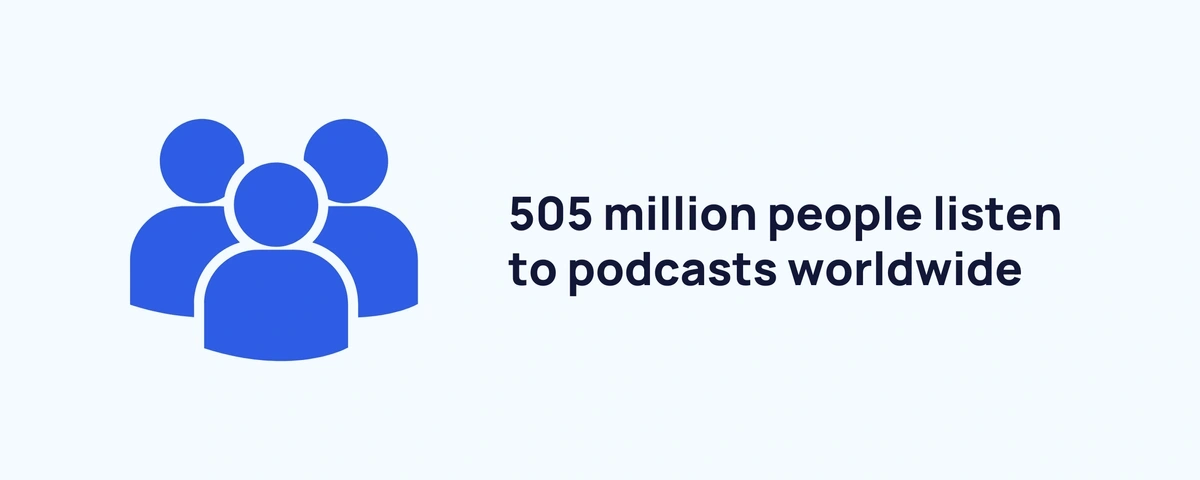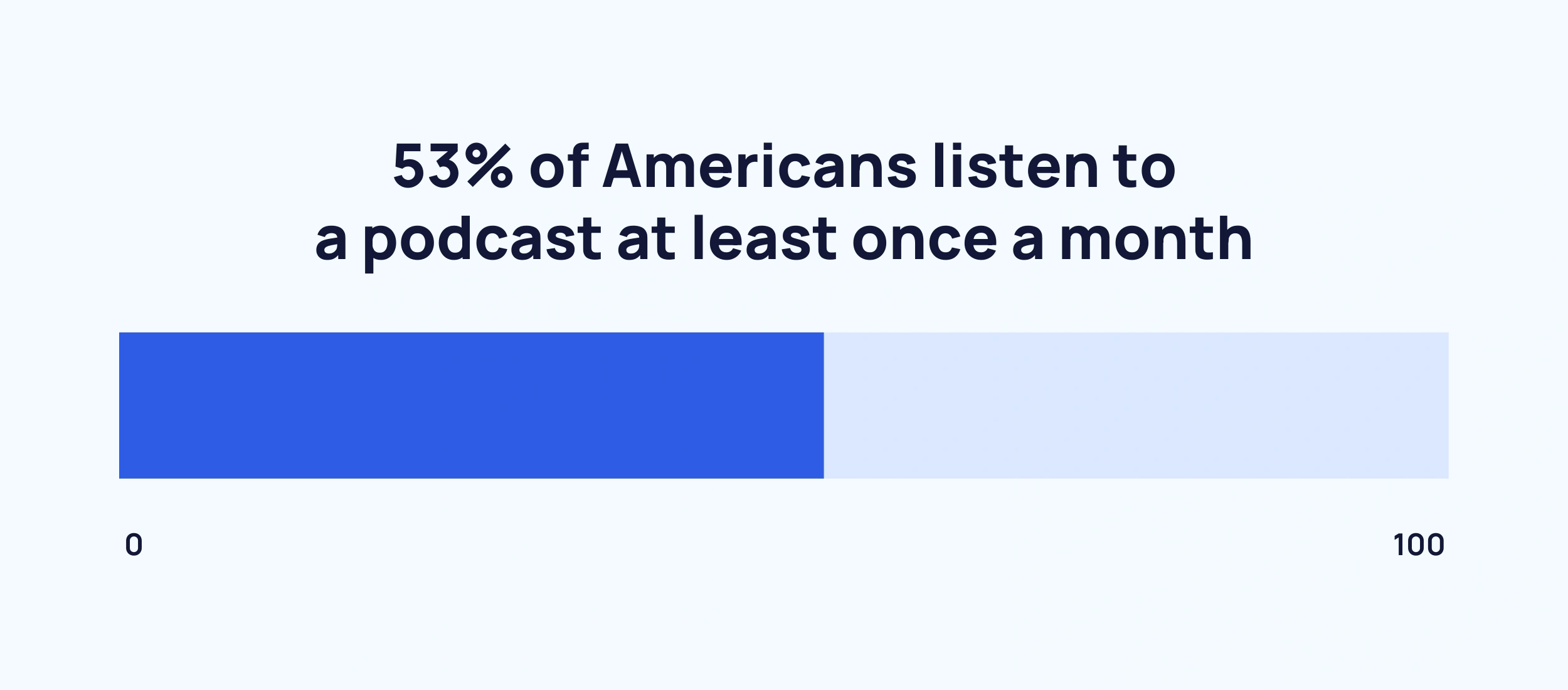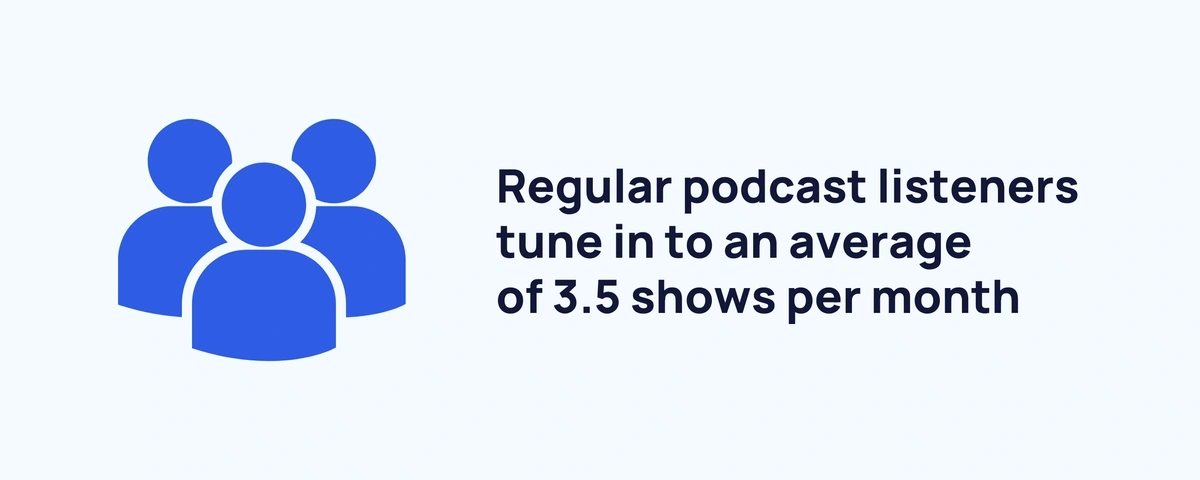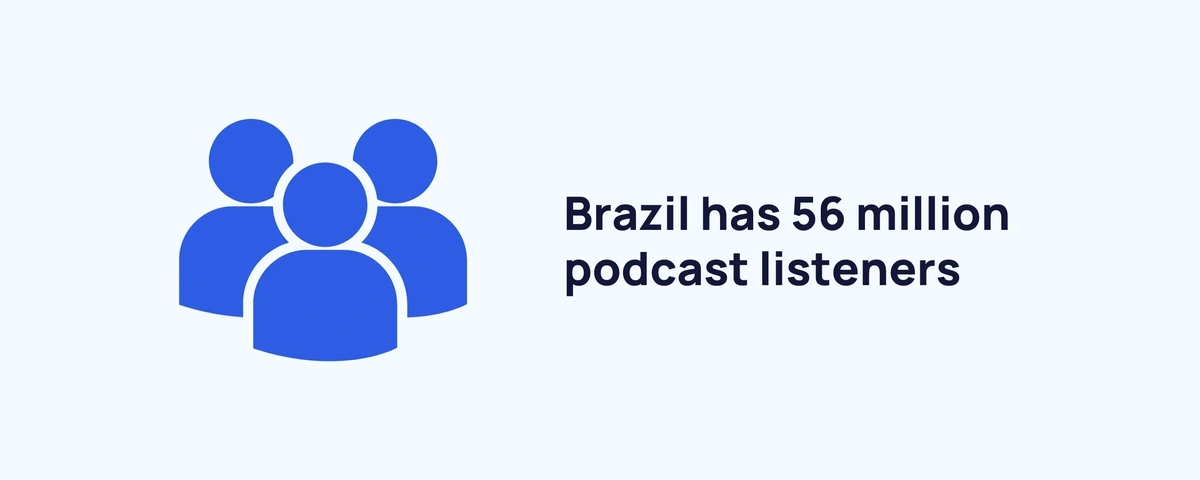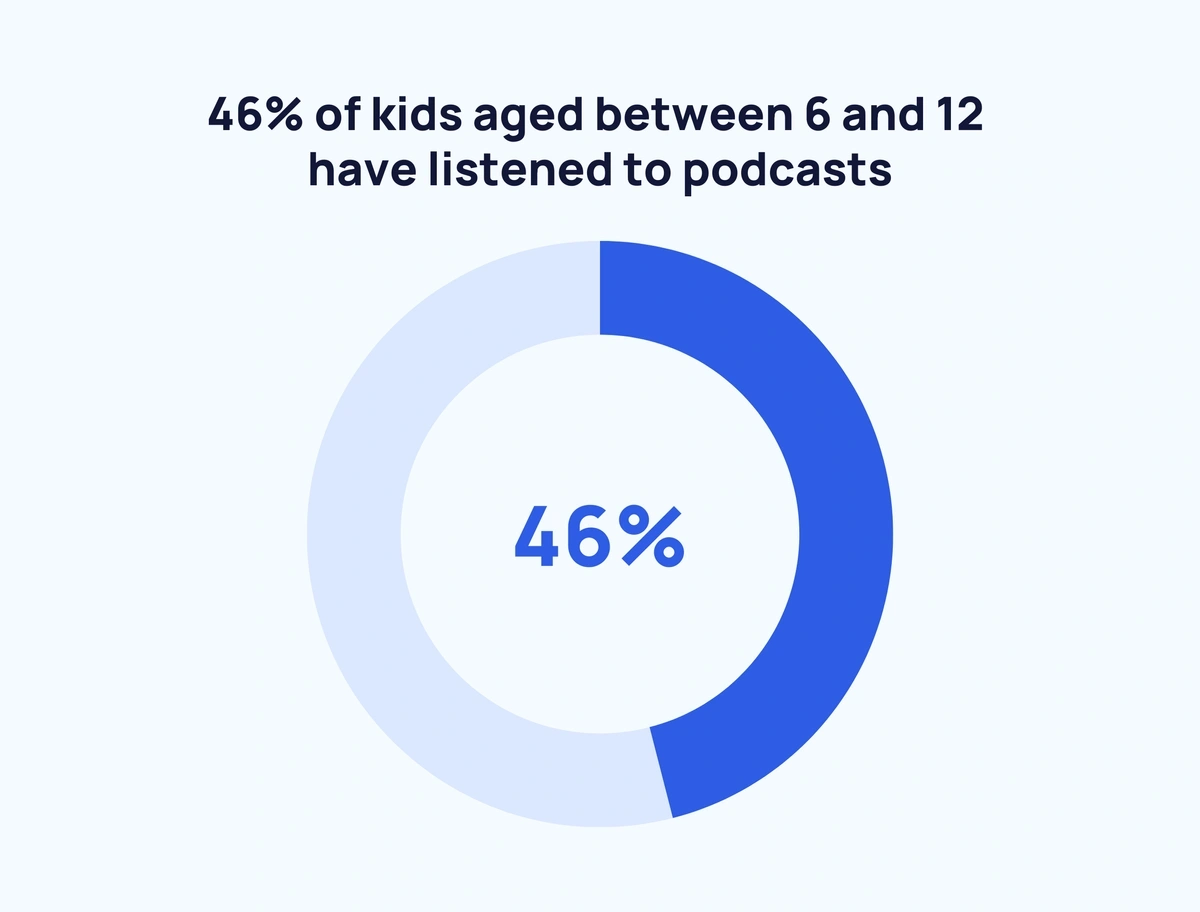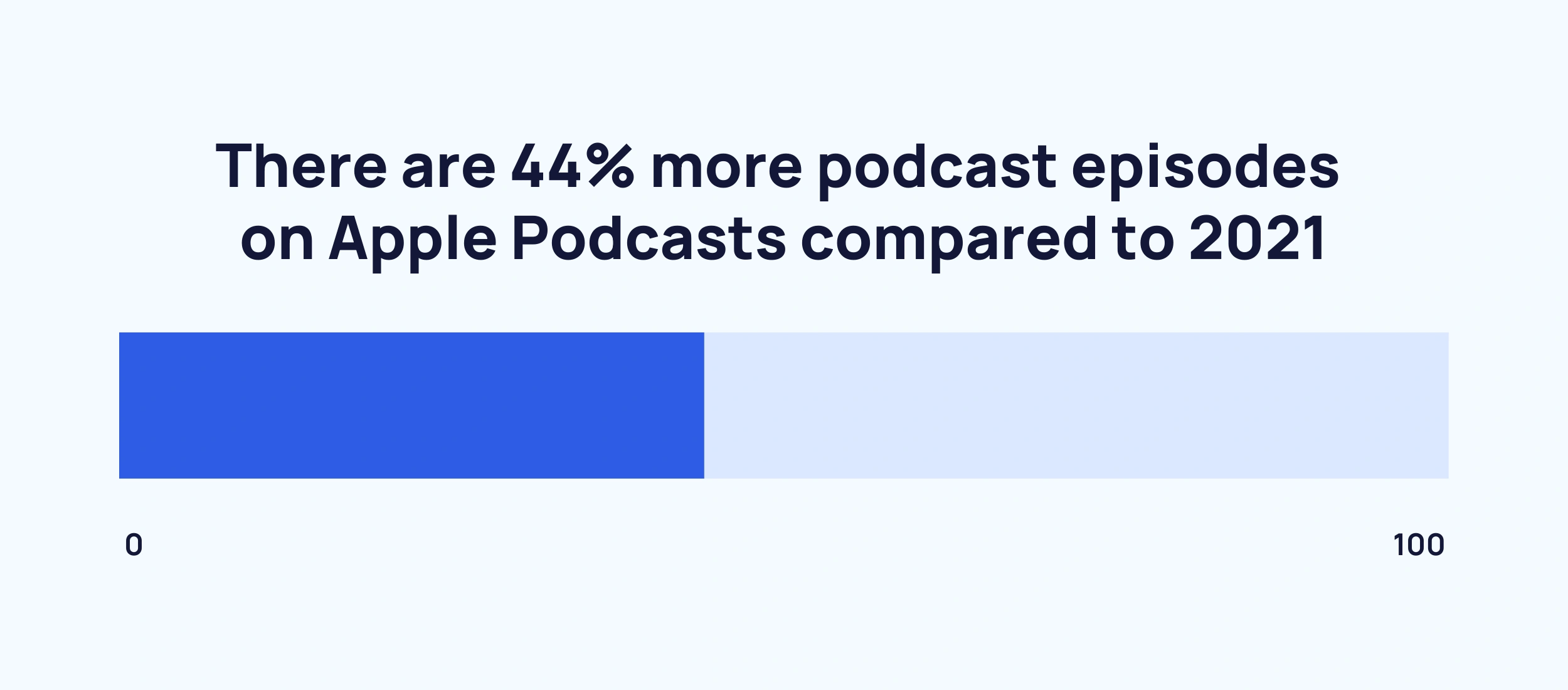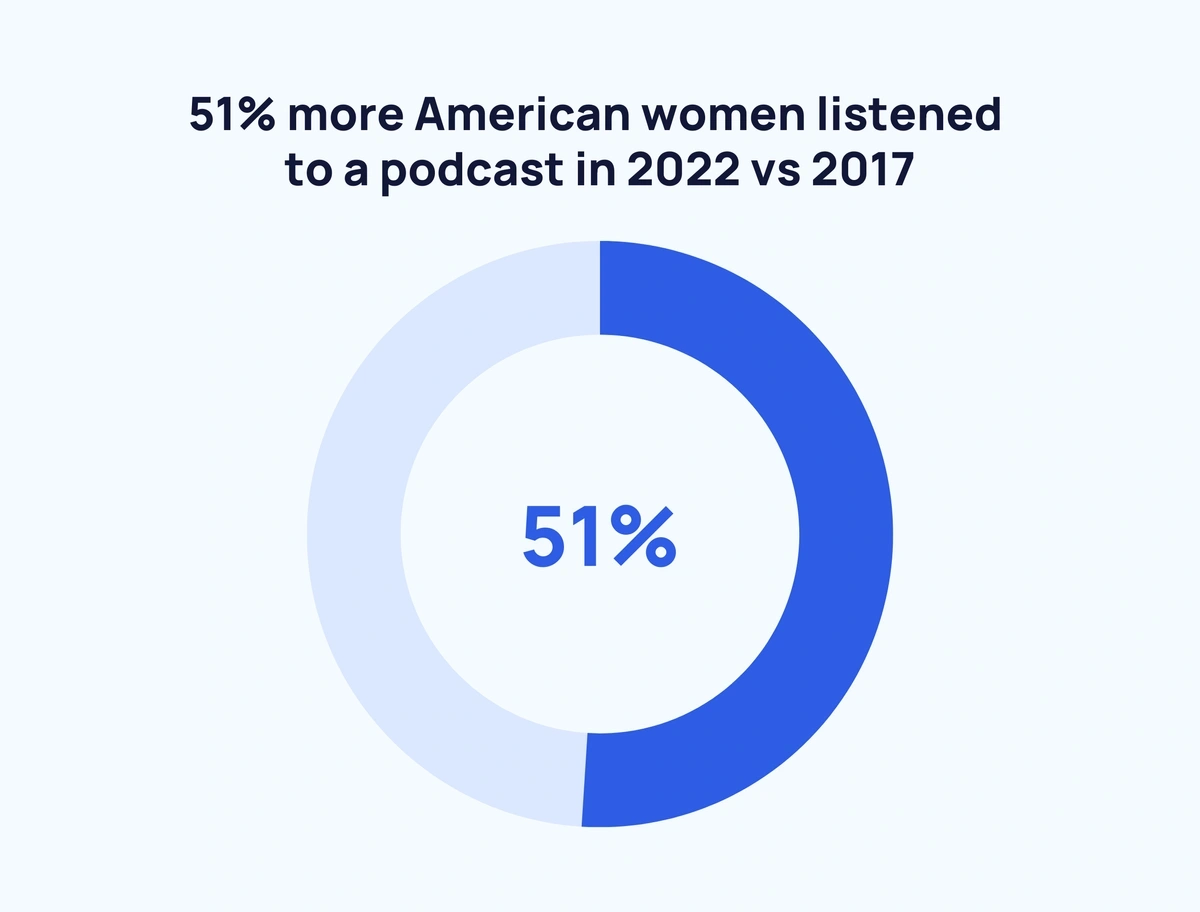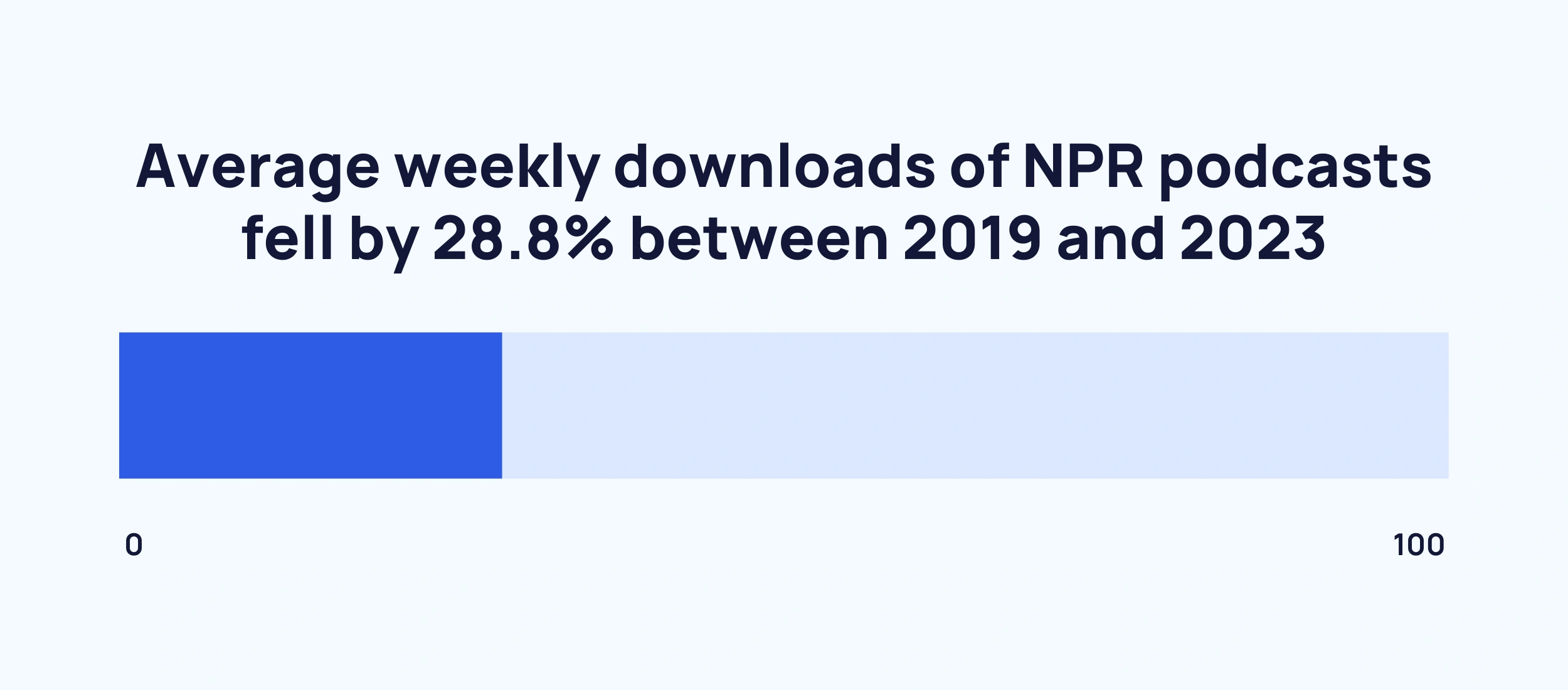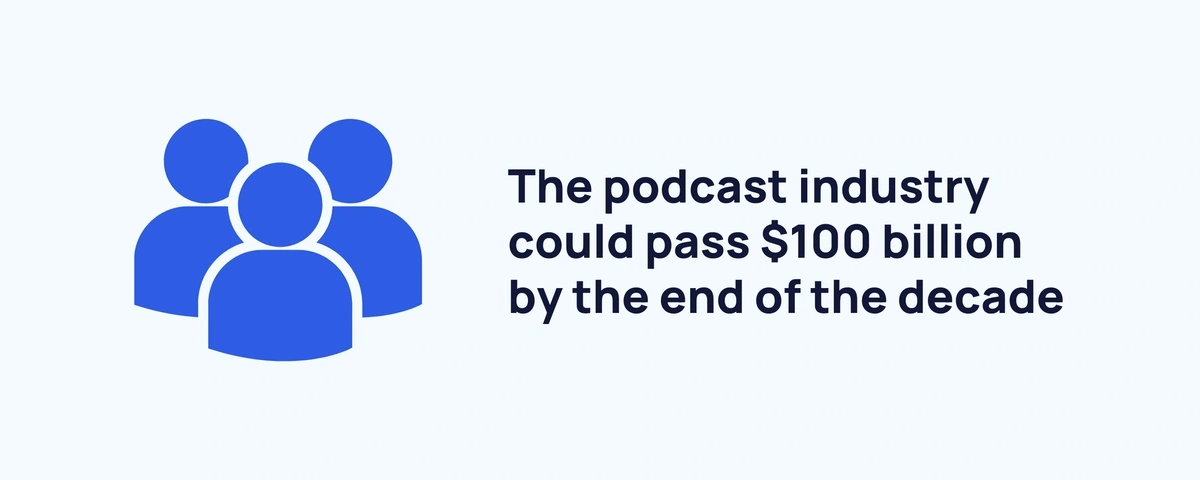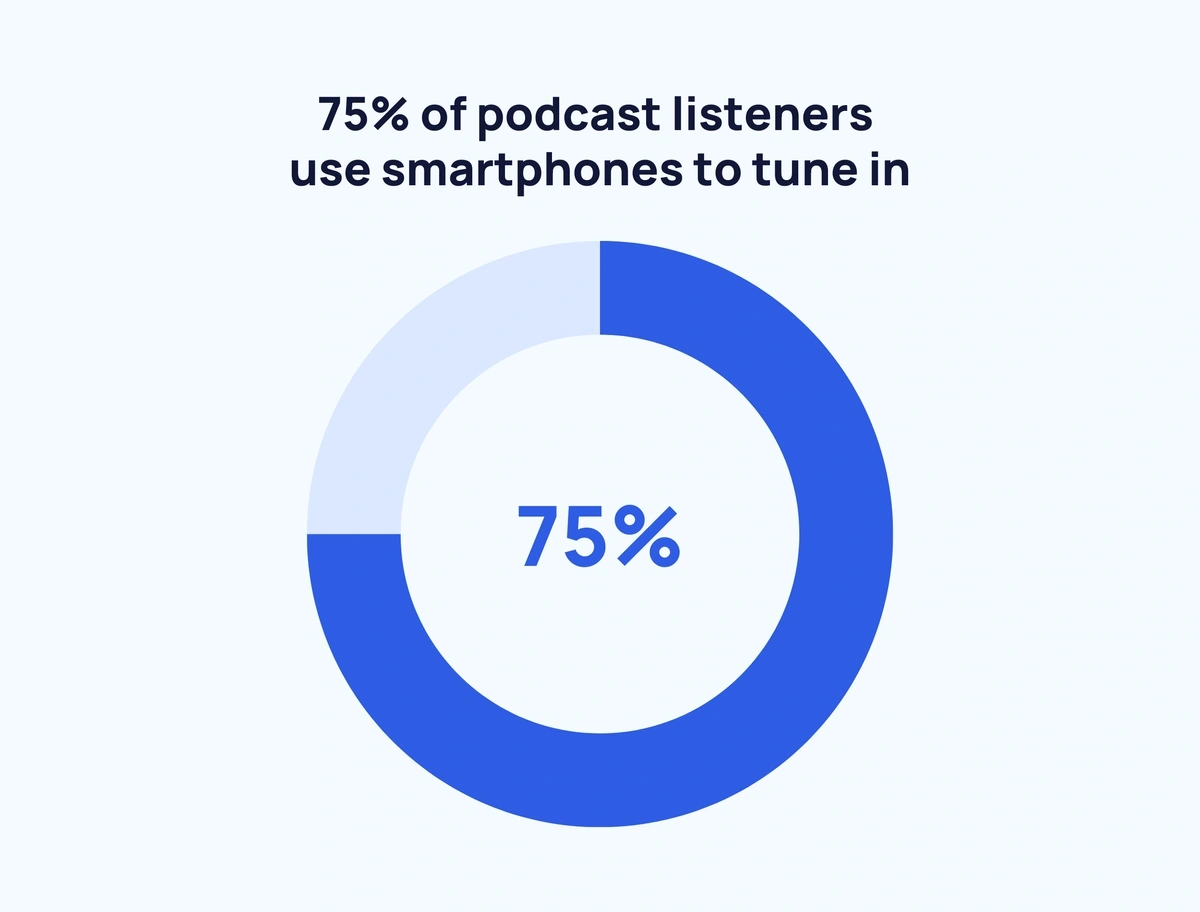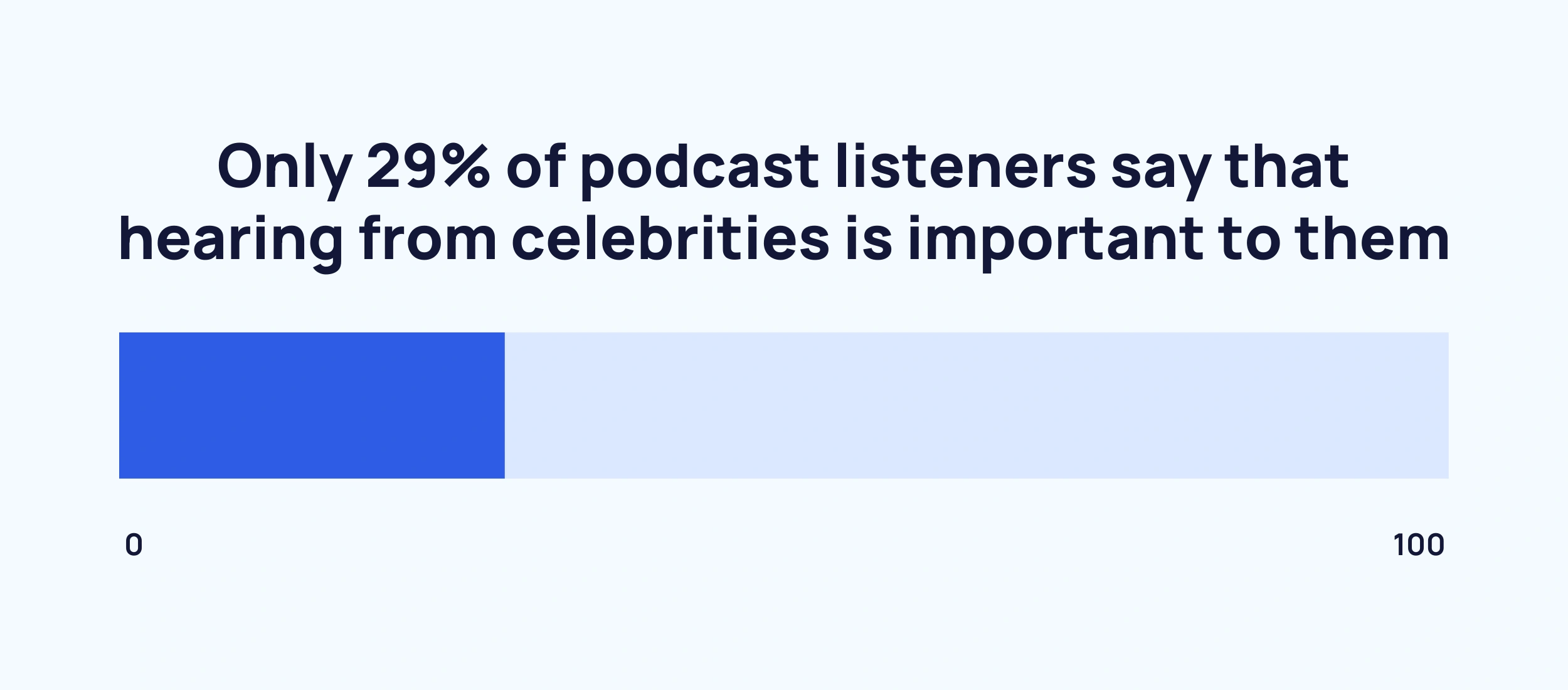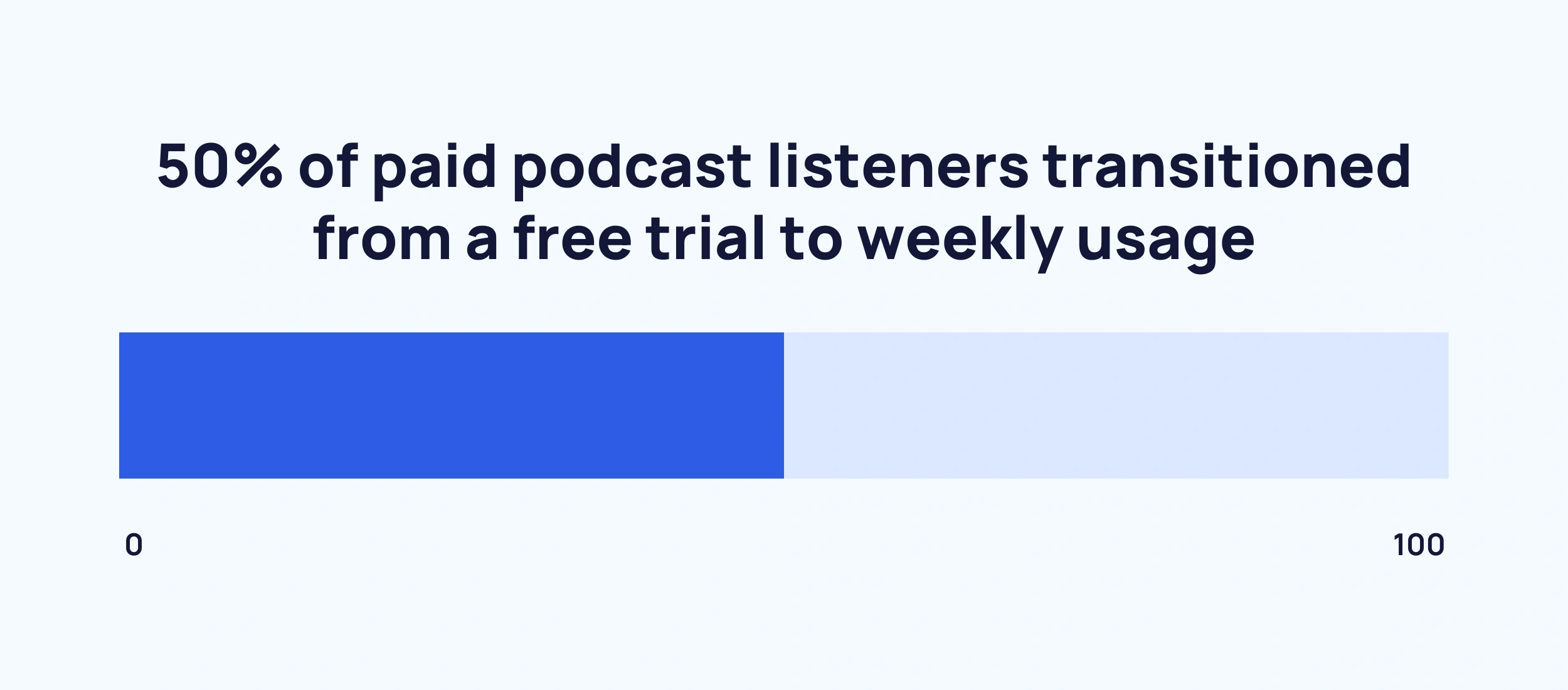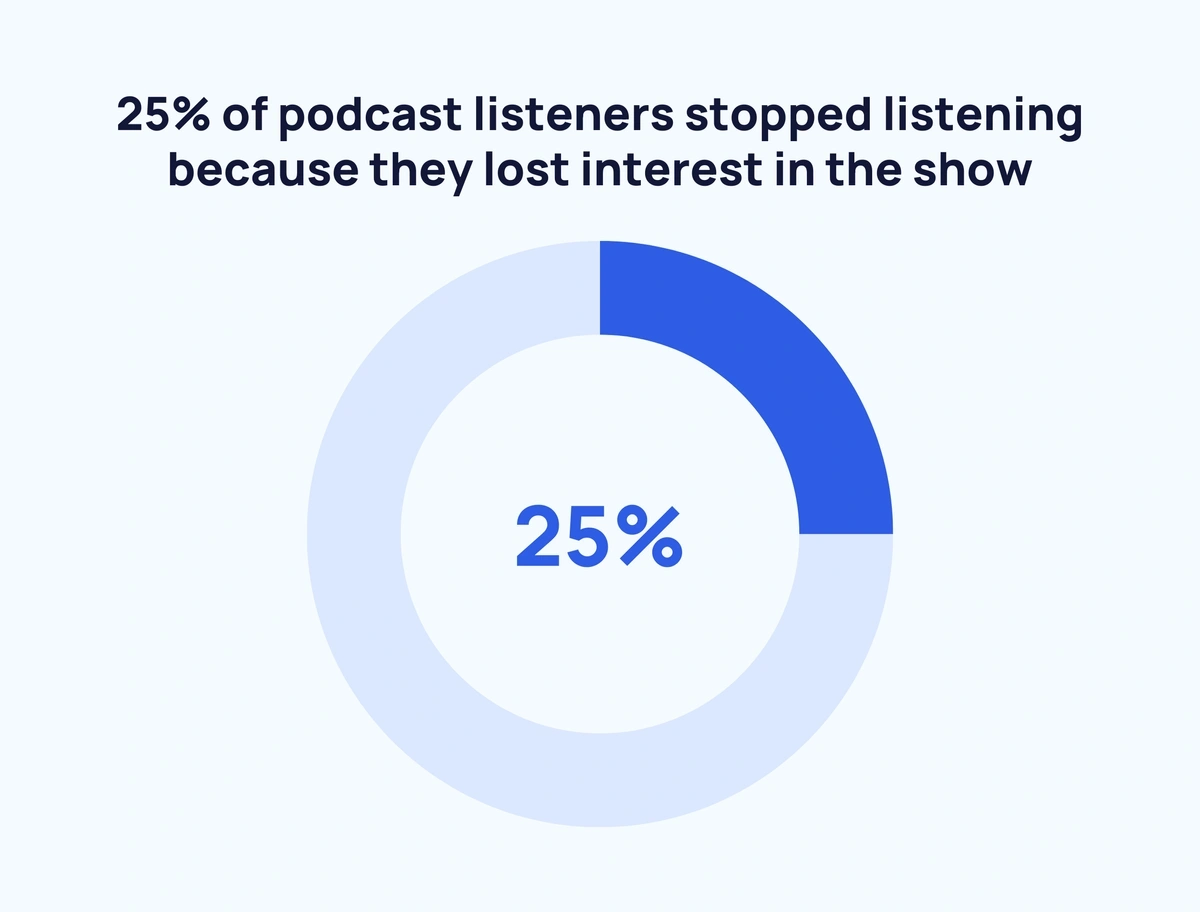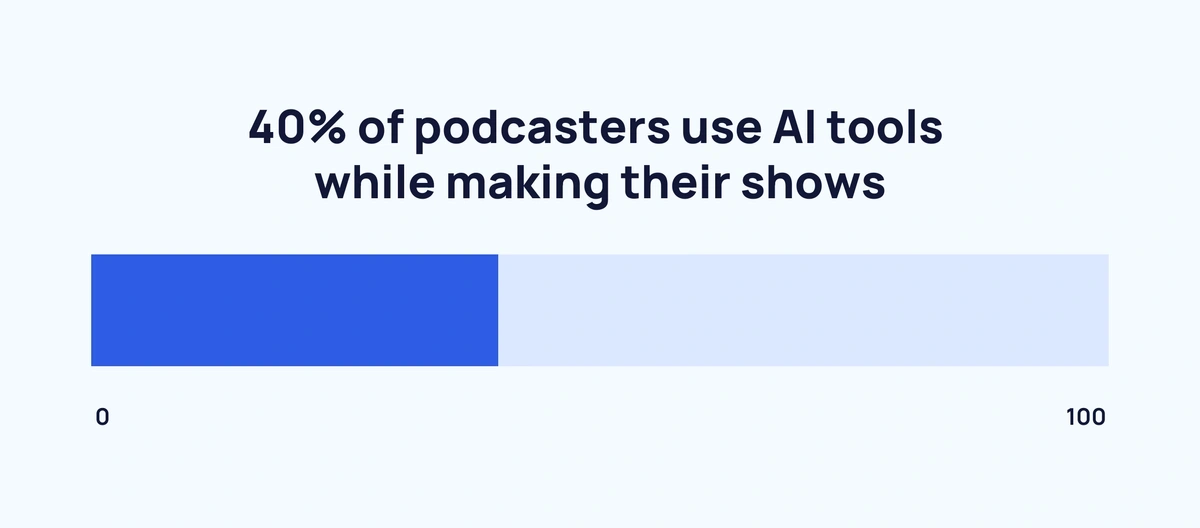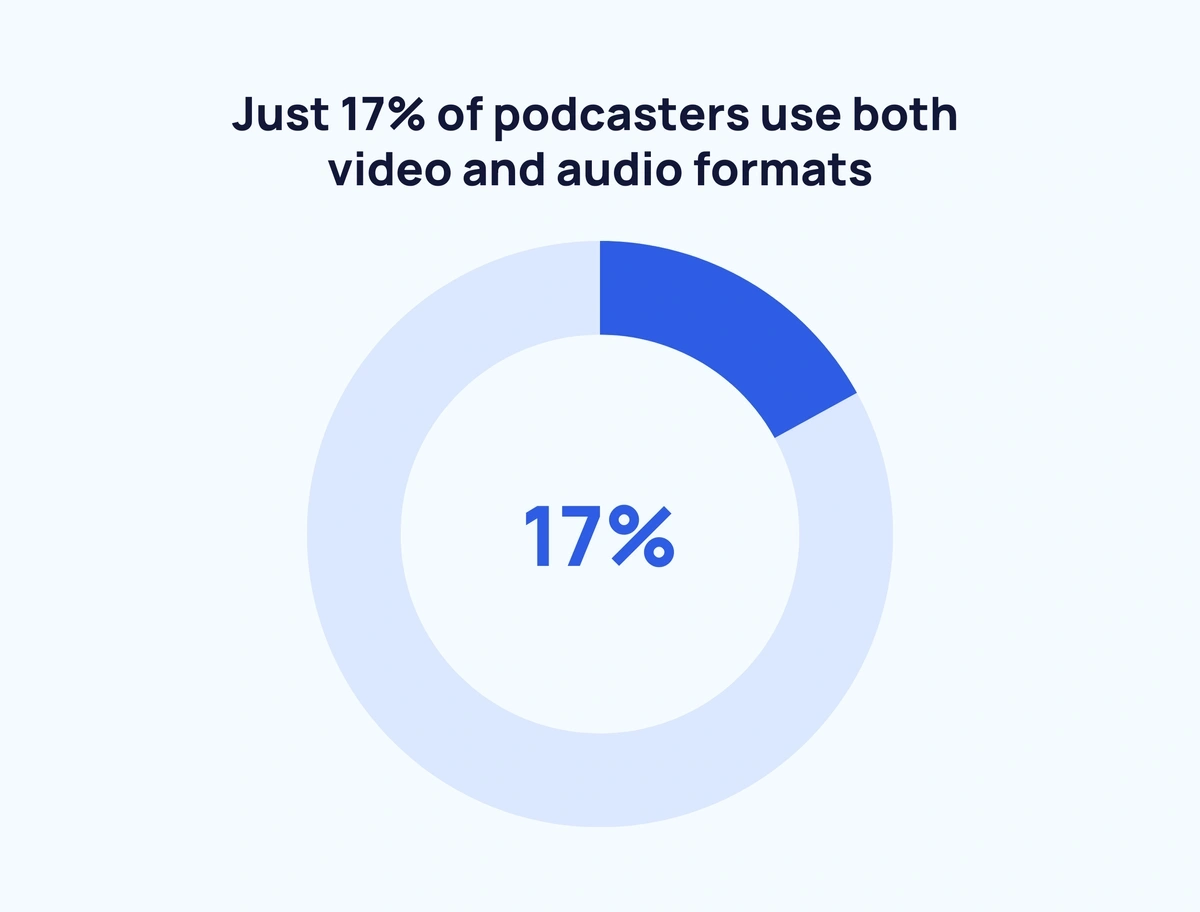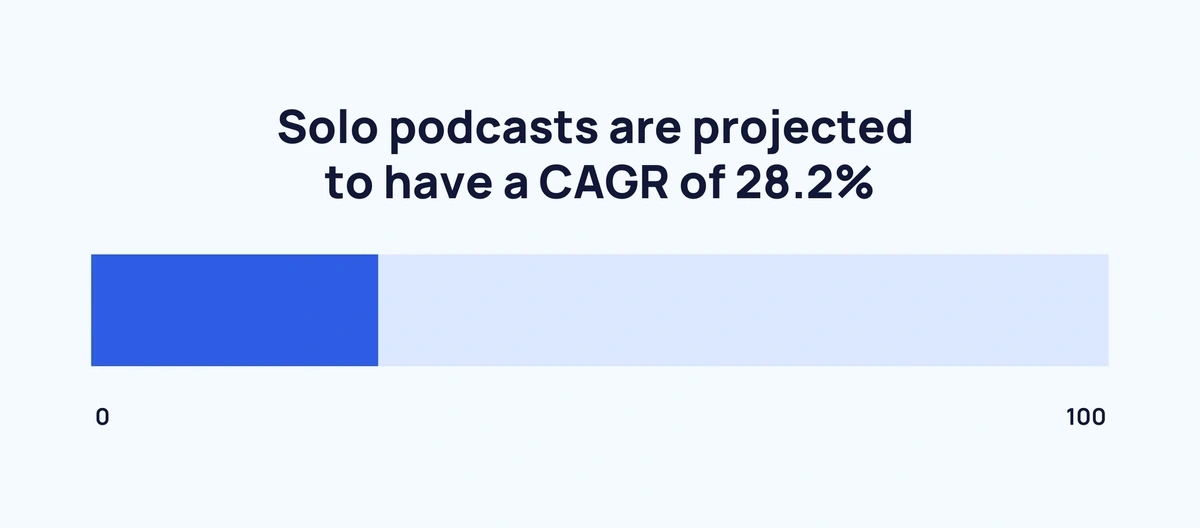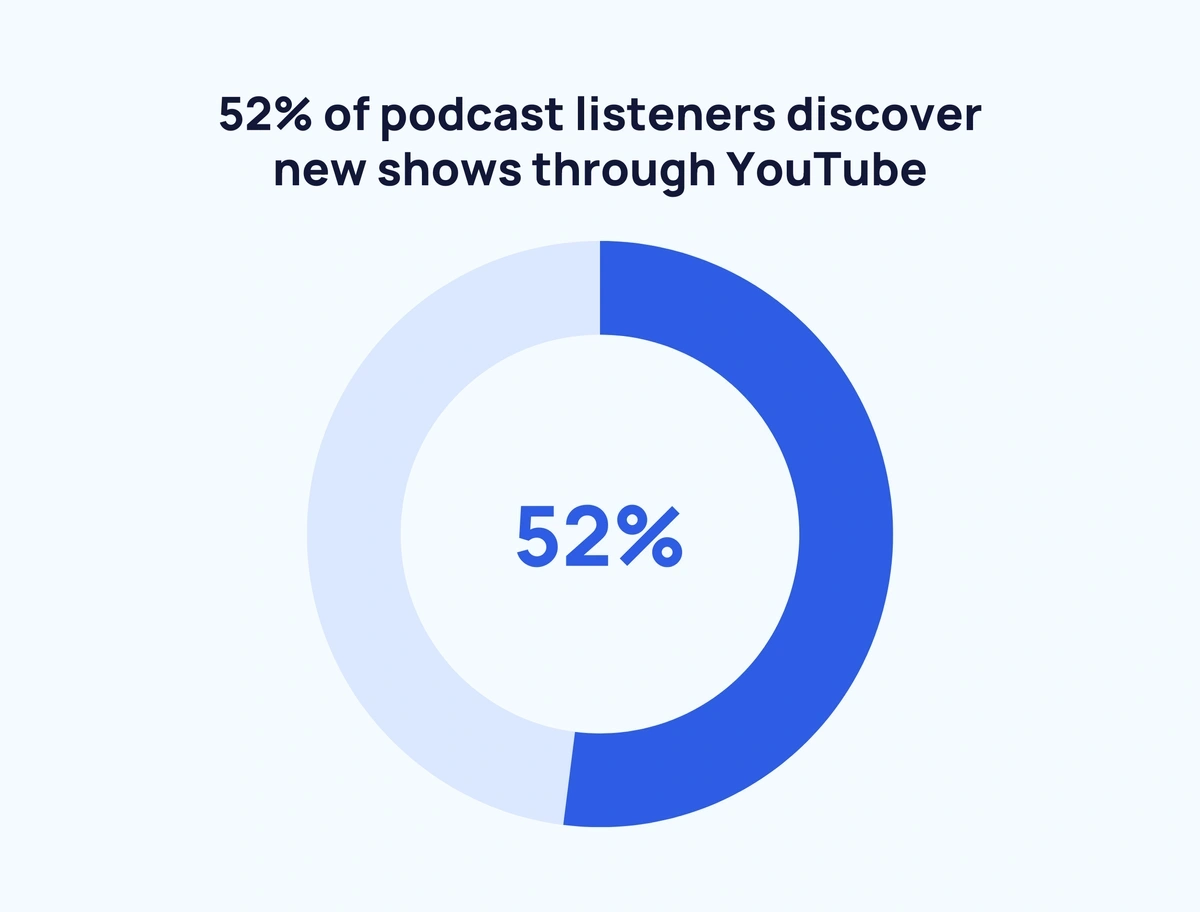
Top 60+ Podcasting Stats for 2024
If video killed the radio star, podcasting might just save it.
Podcasts have never been as popular as they are now. In fact, 2024 was the first time that a majority of Americans listened to podcasts every single month.
But what types of podcasts catch the most attention? If you want to target a certain listener demographic, what genre should you focus on?
In this article, we cover the key statistics and trends about podcasting, updated for 2024.
Editor’s Picks: Top Podcasting Stats
- With 505 million listeners worldwide, podcasting is hugely popular. But it still has room to grow.
- Podcast consumption is highest among young adults. Older adults have yet to engage, particularly women over 55.
- The global podcasting industry could be worth more than $100 billion by the end of this decade.
- Content creators and marketers need sophisticated data to guide their growth strategies. Tools like the Semrush Market Explorer offer valuable insights into competitor performance, market trends, and audience behavior.
Podcasting Popularity Statistics
505 million people listen to podcasts worldwide (Statista)
This is a substantial audience size. However, it’s still just 6% of the global population. That doesn’t take into account the fact that hundreds of millions of people lack access to the internet.
23.5% of global internet users listen to podcasts (Statista)
Impressive, but this actually demonstrates the huge growth potential that podcasting still has. More than three-quarters of internet users don’t listen to podcasts (yet!), and more people haven’t even had the chance to listen to them.
64% of Americans aged 12 and older have listened to a podcast (Pew Research)
That’s the highest figure since Pew began tracking podcast listenership in the early 2000s. For comparison, in 2006, just 11% of Americans had listened to a podcast. In 2014, 30% had.
And 42% of Americans listen to podcasts regularly (Pew Research)
Here, “regularly” means in the past month. In 2023, 42% of Americans listened to a podcast in the last month, while 31% listened to one in the last week.
94% of Americans are familiar with the term “podcast” (HubSpot)
On the one hand, it’s impressive that basically everyone in the U.S. has heard of the concept of podcasting.
The term has been around for over two decades. It was first used in 2004, and is a combination of the words “iPod” and “broadcast.”
53% of Americans listen to a podcast at least once a month (HubSpot)
This study, conducted in June, 2024, found that a majority of American adults listened to podcasts at least once a month — the first time this statistic crossed 50%.
But 26% of American adults have still never listened to a podcast (HubSpot)
Podcasting might finally be in the majority — or, in other words, not a niche hobby anymore — but a quarter of Americans haven’t engaged with podcasts yet.
53% of podcast listeners have been tuning in for 1 to 5 years (HubSpot)
30% of listeners have been listening for 1–2 years, while 23% have been doing so for 3–5 years. In contrast, 18% of listeners have been tuning in for over 5 years, and 17% have only started listening in the last six months.
The top 1% of podcasts are downloaded almost 4,000 times in the week after a show release (Sci-Tech)
To be precise, the average number of downloads for a show published by the top 1% of podcasts is 3,994. That’s based on research done by Podcast Statistics.
91% of Australians over the age of 12 know about podcasts (Australian Broadcast Corporation)
That means podcasts are less well known in Australia than in the United States — albeit only slightly.
Regular podcast listeners tune in to an average of 3.5 shows per month (HubSpot)
Although the average is 3.5 shows, a significant minority of regular listeners — one-fifth, to be exact — listen to five or more titles each month.
But women listen to an average of 5.7 podcasts each (Edison Research)
Notably, that’s a significantly higher figure than the 3.5 average produced by HubSpot. Assuming both studies are accurate, it suggests that women listen to more shows than the average podcast listener.
People who listened to podcasts in the last week tuned in for an average of six hours (HubSpot)
It’s likely no surprise that weekly podcast listeners are putting in some serious hours. At that rate, the average weekly podcast listener would rack up some 312 hours of podcast listening — 13 full days — in a single year.
Build a winning strategy
Get a complete view of your competitors to anticipate trends and lead your market
Statistics on Who is Listening to Podcasts (and Who Isn’t)
Among European countries, Germany has the highest share of podcast listeners, at 23.1% (Sci-Tech)
In comparison, the UK has a listener share of 19%; France has a share of 17.3%; Spain 15.4%; and Italy 14.1%.
Brazil has 56 million podcast listeners (Sci-Tech)
That makes it the largest audience of podcast listeners in Latin America. It’s followed by Mexico, which has 29.9 million listeners, and Argentina, with 10.4 million listeners.
Podcast discovery growth among Generation Alpha was 11% in 2022 (Statista)
That makes listeners aged 13–17 the fastest-growing podcast audience. At least, that’s the case among Spotify users, who were the source of this study.
Notably, the second-fastest-growing audience appears to be people ages 45–54. The slowest-growing group in the study was listeners aged 25–34.
Podcasts are most popular among Hispanic Americans, with 63% listening to them at least once per month (HubSpot)
In comparison, 62% of Asian Americans listened to podcasts every month. Slightly below them are Black Americans, with a monthly listening figure of 59%.
And are least popular among White Americans, with 52% listening at least once per month (HubSpot)
This is particularly interesting, given that the most popular podcasts in the U.S. are overwhelmingly white — at least, their hosts are.
46% of kids aged between 6 and 12 have listened to podcasts (Loopex Digital)
Of these, 74% — almost three-quarters — agree they make car rides more fun. Shows that appeal to parents and their kids could, therefore, see significant success.
Of the Americans who’ve never listened to podcasts, 58% are over 55 (HubSpot)
Older Americans are a significant untapped podcasting market. Shows that appeal to them might face less competition. On the other hand, they might also struggle with a relatively smaller audience.
And 60% are women (HubSpot)
Older women, then, are the largest group of people who’ve never listened to a podcast. Getting them interested in the world of podcasting would be a significant step in making podcasting truly mainstream.
Trends in Podcast Popularity
2.23x more Americans have listened to a podcast than had a decade ago (Podcast Host)
Podcasting’s surge in popularity shows little sign of slowing down. In 2014, just 30% of Americans had ever listened to a podcast. By 2020, 55% — a majority — had listened to one. In 2024, that figure stood at 67%.
There are 44% more podcast episodes on Apple Podcasts compared to 2021 (Podcast Industry Insights)
As of June 2024, there were a whopping 95 million podcast episodes on Apple Podcasts alone. That’s almost twice as many episodes as were present three years before.
But the total number of podcasts worldwide declined by 5.6% between December 2021 and June 2024 (Podcast Host)
That decline could represent people abandoning shows they started during the pandemic. However, it could also be the result of a change in the way the Podcast Index calculated its podcast stats — a change done in part to remove irrelevant shows. Under the new rules, a show must have at least three episodes, with one at least three minutes long, to be counted.
In the month of September, some 330,000 podcast shows were published (Podcast Index)
Podcast Index tracks the number of podcast shows published around the world. The number of new shows being added every few days is almost unbelievable. In September 2024, more than 330,000 podcast shows were published. As of the time this was written, more than 100,000 had been published in the previous three days alone!
51% more American women listened to a podcast in 2022 vs 2017 (Edison Research)
The number of podcast listeners in the US is growing. In 2017, just 37% of adult American women had ever listened to a podcast. Five years later, that figure was 56%.
China is projected to experience rapid growth in podcasting, with listeners projected to increase by 28.7% by 2026 (Demand Sage)
In 2024, China’s listener share was 12.9%. By 2026, it’s estimated that figure will grow to 16.6%. That’s still far less than dominant podcasting markets like the U.S., Europe, and Latin America; China’s growth, however, is set to be relatively larger than that of any of the currently dominant markets.
While North America’s podcast listener share is projected to increase by 5.7% (Demand Sage)
North America has the largest podcast listener share in the world. In 2024, it stood at 43.8%. It’s projected to remain the dominant podcasting market; by 2026, the figure is estimated to stand at 46.3%. That’s far larger than China’s listening share but represents a relatively far smaller increase.
The percentage of Americans who listened to a podcast regularly dropped by 7.3% between 2021 and 2022 (Pew Research)
Podcasting as a whole has grown over the last few years. But it declined a little in 2022.
- In 2021, 41% of Americans aged 12 and older had listened to a podcast in the past month, the highest figure since records began in the early 2000s.
- In 2022 that figure fell to 38%, the first time regular podcast listenership fell since 2013.
It’s likely that as pandemic restrictions loosened, fewer people listened to podcasts regularly as did during the lockdowns of 2020 and 2021.
Average weekly downloads of NPR podcasts fell by 28.8% between 2019 and 2023 (Pew Research)
In 2019, NPR’s unique weekly downloads peaked at 11,275,441. By 2023, that figure had fallen to 8,030,222.
The percentage of Americans who listened to online audio in the past week increased by 775% over the last two decades (Pew Research)
In 2003, just 8% of Americans aged 12 and older listened to online audio in the past week. By 2013, that figure was 33%. 2023 saw that figure rise to 70%. Even more Americans listened to online audio in the past month: 17% in 2003, 45% in 2013, and 75% in 2023.
Chile’s podcast industry is set to grow by 84% (Voxnest via Scoop)
That’s the fastest growth of any regional podcast industry, according to this study. Chile is followed by Argentina, then Peru, then Mexico, and then China.
Latin America’s podcast industry is projected to have a CAGR of 28.4% over the next decade (Market US)
This CAGR (Compound Annual Growth Rate) would make it the fastest-growing region in the global podcasting market, according to this study.
83% of regular podcast listeners in 2023 listened to the same or more podcasts in 2024 (HubSpot)
In this instance, “regular” means those who listened to at least one podcast in a month. 45% of these people listened to more podcasts in 2024 compared to 2023, while 38% reported no change in their listening habits. That leaves 17% who have dialed down their podcast listening.
Podcasting Market Size Statistics
The podcast industry could pass $100 billion by the end of the decade (Demand Sage)
That represents a whopping threefold increase — and then some. For context, the worldwide traditional radio market is estimated to be worth around $35 billion in 2024.
The podcast market grew at a CAGR of 27.8% in 2023 (Market Report)
CAGR stands for compound annual growth rate. It represents the average rate of revenue growth over a year. Using this figure, the podcasting market could pass $233 billion by 2032!
In 2024, the leading podcast publisher is iHeart Audience Network (Sci-Tech)
iHeart had a whopping 647 million unique streams and downloads in June 2024, making it the most popular podcast publisher in the world.
Track key market movements with the Semrush Market Explorer to identify emerging opportunities in the podcast space.
Top Podcast Listener Statistics
71% of Zoomers who regularly listen to podcasts watch the video versions of their chosen shows (Loopex Digital)
And 49% of them say that the video lets them better understand the tone and context of what’s being said. All in all, these are good arguments for integrating video into your podcasting.
Check out our guide to the latest video trends for more ideas.
75% of podcast listeners use smartphones to tune in (Loopex Digital)
Unsurprisingly, smartphones are by far the most common tool used to listen to podcasts. In comparison, just 13% of people use a laptop or desktop computer to listen to podcasts.
Apple Podcasts has a 6.3% higher share of podcast listeners than Spotify (BuzzSprout)
Apple Podcasts might have been in the game for longer, but Spotify’s aggressive marketing — which has cost the company hundreds of millions of dollars — seems to have worked. The two companies are neck and neck when it comes to dominance in the podcast market. According to BuzzSprout, Apple Podcasts still has the lead, with 36.2% of podcast listeners. Spotify, meanwhile, has 34% of listeners.
Statistics on Why People Listen to Podcasts
82% of people who listen to podcasts do so to hear discussions on topics that interest them (HubSpot)
Listening to people discuss topics you like is by far the most common reason podcast listeners cite as an important reason they tune in. The next four most important reasons were all some variation of having something on in the background — while driving, walking, exercising, doing chores, or just in general to keep you company.
Check out our list of trending marketing podcasts.
Only 29% of podcast listeners say that hearing from celebrities is important to them (HubSpot)
That was the least popular answer among those in the survey. It perhaps suggests that podcasters shouldn’t worry so much about securing celebrity guests and focus on discussing topics their listeners want to hear.
70% of podcast listeners prefer ads that are read by the host, as opposed to pre-recorded ones (Sci-Tech)
Integrating ads into podcasts can be tricky. Too many ads or pre-recorded spots may turn listeners away, as most prefer ads read naturally by the host.
To find the right advertising partners, Semrush Market Explorer helps podcasters analyze market trends and identify potential advertising opportunities, helping them craft ad strategies that resonate with listeners.
60% of podcast listeners tune in to be entertained (Loopex Digital)
This was the most popular reason for listening to podcasts, according to Loopex Digital’s research. The second most common reason was to learn, which was cited by 55% of listeners.
50% of paid podcast listeners transitioned from a free trial to weekly usage (HubSpot)
Podcasters who want to keep their content behind a paywall should consider offering something for free, as research suggests that conversion rates are quite high.
58% of Zoomer podcast listeners see podcasts as their primary connection to modern pop culture (Loopex Digital)
Appealing to young podcast listeners — who are becoming an increasingly important part of the market — apparently involves discussing contemporary culture.
Statistics on Why People Stop Listening to Podcasts
25% of podcast listeners stopped listening because they lost interest in the show (HubSpot)
That was the most common reason cited by lapsed listeners.
Following this was
- Losing interest in the topic discussed (22%)
- Getting bored of repetitive content (15%)
- Becoming annoyed with the number of ads (15%)
- Refusing to pass a paywall (13%).
Issues like an inconsistent publishing schedule, changes in episode length or publishing schedule, and audio problems — which might seem important to podcasters — were mentioned very infrequently as reasons people stopped listening.
In other words, podcasters should focus on ensuring their content is interesting, fresh, and relevant, and worry less about the technical details.
41% of those who haven’t listened to podcasts recently say they haven’t got enough free time to do so (HubSpot)
Simple lack of time is the most commonly cited reason for not listening to podcasts — at least, by people who would otherwise listen to them. Unfortunately, that’s not really something podcasters themselves can do anything about.
34% of people who’ve never listened to a podcast say their other entertainment options give them all they need (HubSpot)
The most frequently cited reason for never listening to podcasts could be described as a lack of curiosity. This could be overcome by emphasizing the unique benefits that podcasts provide. Alternatively, podcasters could try and demonstrate how their shows are similar to existing entertainment options, like radio, to appeal to these listeners.
22% of people who’ve never listened to podcasts don’t understand the benefits of them (HubSpot)
Similarly, 15% say they’ve never listened to podcasts because they don’t know how. Explaining the benefits of podcasts and how to listen to them — which these days is just as easy as listening to music — seems like a remarkably easy way to increase the overall audience of podcast listeners.
Podcast Creation Statistics
40% of podcasters use AI tools while making their shows (Loopex Digital)
Don’t worry, this doesn’t mean your favorite podcasters are churning out fully AI-generated shows. In this context, “AI tools” means using chatbots for idea generation and using transcription tools during production.
85% of listeners think it’s OK for podcasters to use AI (Acast via Sci-Tech)
Perhaps there’s no need to worry anyway — despite the controversy surrounding the use of AI in creative industries, the vast majority of podcast listeners believe it’s ethical for podcasters to use AI tools during the production process.
11% of women who listen to podcasts produce their own show (Edison Research)
It appears most podcast listeners are just that. Still, a significant minority of listeners (at least among women) also dabble in podcast creation themselves.
Just 17.2% of the shows on Apple Podcasts are currently active (Podcast Host)
The vast majority of podcasts are inactive. In this case, “active” means having posted a new episode in the last 90 days.
Just 17% of podcasters use both video and audio formats (Sci-Tech)
Considering the popularity of video among listeners — especially younger ones — a surprisingly low proportion of podcasters integrate it into their shows.
55% of podcast listeners say they wouldn’t care if a podcast was produced by a company (HubSpot)
You could take this either way. On the one hand, it suggests that partnering with or selling to a production company wouldn’t upset the majority of listeners. On the other hand, 45% is a pretty significant minority, and losing that many listeners might not be worth the potential benefits of joining forces with a company.
Podcast Genre and Format Statistics
Interviews are the most popular podcasting style, with 30.6% of the market share (Market US)
Interviews are a classic of both traditional radio and modern podcasts. In fact, many of the most popular podcasts today only use the interview format. This style of podcast is projected to have a CAGR 27.8%. Notably, this doesn’t make interviews the fastest-growing podcast style.
Solo podcasts are projected to have a CAGR of 28.2% (Market US)
Solo podcasts might have a smaller market share than interviews — 25.7% compared to the latter’s 30.6% — but they are expected to grow in popularity slightly faster.
News and Politics generates 31.7% of global podcast revenue (Market US)
That makes this genre the most lucrative. However, it’s not necessarily the most popular, in terms of raw numbers.
35% of podcast listeners choose comedy (HubSpot)
That makes comedy the most popular genre of podcasts. It’s followed by news (31%) and sports (30%).
And 40% of women podcast listeners tune into comedy shows (Edison Research)
That made comedy the most popular genre of podcasts among women listeners — at least in August 2022, when this research was published. The second-most popular genre of podcasts was true crime, which captured 37% of women listeners.
Statistics on How People Discover Podcasts
52% of podcast listeners discover new shows through YouTube (HubSpot)
That makes YouTube the most common way for listeners to discover new shows — by a large margin. It’s followed by:
- Searching the internet (27%)
- Facebook (27%)
- Hearing a recommendation from another podcast host (23%)
- Spotify (23%).
These figures exclude personal recommendations.
35% of younger women discover new podcasts on social media (Edison Research)
Social media is the best way to reach new audience members, at least among younger generations. Younger women are also more likely to find new podcasts from watching TV.
34% of older women find new podcasts through recommendations by family and friends (Edison Research)
If you’re aiming for an older audience, you should focus on word-of-mouth, as that is the most common way older women discover new shows. (It’s also one of the most common ways all women listeners found new podcasts, according to the linked study.)
Notably, older women were the most likely to discover new shows by reading about them in an article. If they are your audience, working to get mentioned in magazines and newspapers could be a great way to grow.
Podcasting in 2024 and Beyond
As the popularity of podcasting continues to trend up, 2024 presents opportunities for creators and marketers. There’s substantial room for expansion, especially among underrepresented demographics such as older adults.
For content creators, understanding listener behaviors (like preferences for host-read ads) can be pivotal to building a loyal audience.
Stop Guessing, Start Growing 🚀
Use real-time topic data to create content that resonates and brings results.
Share
Newsletter Signup
By clicking “Subscribe” you agree to Semrush Privacy Policy and consent to Semrush using your contact data for newsletter purposes
Written By


Josh is the Co-Founder and CTO of Exploding Topics. Josh has led Exploding Topics product development from the first line of co... Read more

